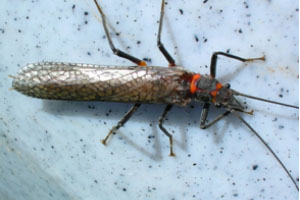The giant salmonfly is an important food source for native trout. Both the larvae and adults are used as models by fly fishermen to create artificial trout lures. Emergences are routinely reported in sports pages of many western North American newspapers. In the Robert Redford movie "A River Runs Through It,� a character switches to a lure patterned after a stonefly that has just landed on him, because he knows this particular species is emerging from the river right then and the trout will be feeding on them.
Photo Credit: Phinfish via Wikpiedia Commons
Pteronarcys californica
Common Name: giant salmonfly
Other Common Names: giant western salmonfly
Animal Guild: Insect
Class > Order > Family: Insecta > Plecoptera > Pteronarcyidae
What does the species look like?
Adult: Stonefly adults have two stout tails and two pairs of wings that lay flat over the body when at rest. The giant salmonfly is an exceptionally large stonefly measuring 1.18 to 1.97 inches (30 to 50 mm) in length, with a wingspan of 1.97 to 3.31 inches (50 to 84 mm). The wings, head, and top of abdomen are dark brown; with a paler, orange brown bottom of the abdomen; and orange band just behind the head that appears as a reddish-orange line down the middle of the midsection. . Adult salmonflies are easily recognized by the large size and abundant crossveins in the forewing anal area that give them a net-like appearance. These gills are reduced to small stubs in the adults. Males and females are easily distinguished by genitalia Total length: 1.18-1.97 inches (30-50 mm); wingspan: 1.97-3.31 inches (50-84 mm) (males smaller than females).|Similar Species: Range only overlaps with two other potentially confusing species, the American salmonfly (Pteronarcys dorsata) and the ebony salmonfly (Pteronarcys princeps), however differentiating these species is difficult except for the most experienced observers. The ebony salmonfly is generally darker and typically found in small streams on the west coast, but also inhabits isolated mountain ranges of Nevada, eastern Oregon, and southwestern British Columbia. The tenth sternum (= ventral plate; essentially the very last segment) is greatly narrowed ventrally and is rounded and raised (as opposed to broad like most species or absent in the American salmonfly). The American salmonfly resembles the giant salmonfly in coloration but the ninth abdominal sternum (= ventral plate) of males projects over the tenth and is notched on the posterior margin (making the tenth plate appear absent); plus it only gets as far west in the Rocky Mountains as the Mississippi-Missouri drainage basin.|Nymph: Stonefly nymphs are differentiated from other aquatic insect nymphs by their two stout tails and dual wingpads on the thorax. Nymphs of this species are exceptionally large and are colored black or dark chocolate brown with branched, fluffy gills protruding from between the legs (visible from above) giving them a hairy armpits appearance. They are notoriously difficult to differentiate from other nymphs of the same genus. Total length: 1.38-1.97 inches (35-50 mm).|Similar Species: Caddisfly nymphs are notoriously difficult to identify, however, In mature nymphs of the giant salmonfly, the prothoracic (= corner) teeth are directed outward and are sharp and longer than their basal width (unlike the American salmonfly and the ebony salmonfly, which have short, blunt corner teeth that are no longer than their basal width).
Where is the species found?
States & Provinces
AB, AK, AZ, BC, CA, CO, ID, MT, NM, NV, OR, UT, WA, WY, YT
Distribution
The range includes the Coast, Cascade, Rocky, and Sierra Nevada Mountains northward to Alaska and Yukon and southward to Mexico where it has been recorded disjunctly in Durango. It is found throughout the northern and eastern Basin and Range province of the western U.S. but is conspicuously absent in the western Great Basin, where the ebony salmonfly is the sole representative of the genus.
Adults and larvae are associated with fast-moving mountain streams or large to medium sized rivers at relatively low to moderate elevations, usually below 7000 feet. Streams are often clean and of moderate to high velocity and nymphs are frequently found in medium to large-sized, unconsolidated rocky substrates.
General Phenology and Life History
This species has a 2-, 3-, or rarely 4-year life cycle. After three years in the water, mature nymphs emerge along the shoreline. Emergence is heaviest near dawn and dusk. Adults are present in Alaska and western Canada mostly in May and June. Emergence time depends on water temperature and in the contiguous states is generally April to June. In eastern Idaho, it ranges from mid-May to as late as mid-June, early April through early May in northwestern Montana, and throughout May in southern Alberta. It is on the wing in western mountains during June, July, and August.
Which phenophases should I observe?
Do you see/hear...?
Activity
Adults More...
For abundance, enter the number of individual animals observed in this phenophase.
Reproduction
Mating For abundance, enter the number of individual animals observed in this phenophase.
Egg laying Pteronarcys californica , females often fly low over the water surface and drop their large, black egg sacks from above.
For abundance, enter the number of individual animals observed in this phenophase.
Development
Recently emerged adults For abundance, enter the number of individual animals observed in this phenophase.
Dead adults For abundance, enter the number of individual animals observed in this phenophase.
Method
Individuals at a light For abundance, enter the number of individual animals observed in this phenophase.
Individuals in a net For abundance, enter the number of individual animals observed in this phenophase.
Individuals in a trap For abundance, enter the number of individual animals observed in this phenophase.
What do these phenophases look like?
There is currently no photoguide available for this species. If you'd like help us create one, use the guidance document and species template provided here . Then send it via email to education@usanpn.org when it is complete.
